Acura CL 2003 Owner's Guide
Manufacturer: ACURA, Model Year: 2003, Model line: CL, Model: Acura CL 2003Pages: 355, PDF Size: 4.18 MB
Page 31 of 355
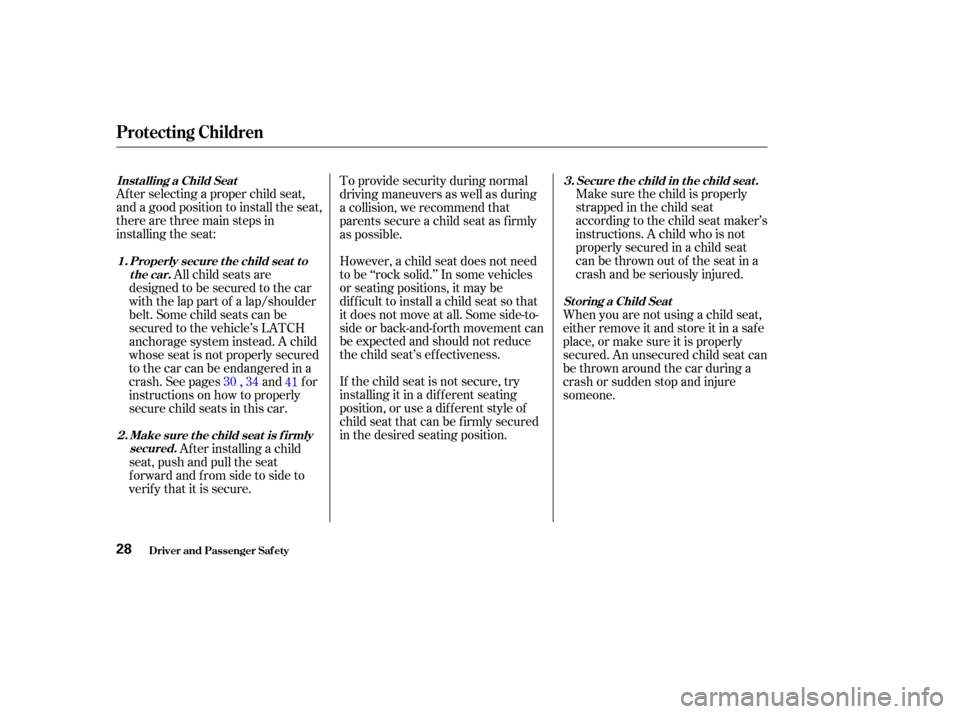
Af ter selecting a proper child seat,
and a good position to install the seat,
there are three main steps in
installing the seat:Make sure the child is properly
strappedinthechildseat
according to the child seat maker’s
instructions. A child who is not
properly secured in a child seat
canbethrownoutof theseatina
crash and be seriously injured.
To provide security during normal
driving maneuvers as well as during
a collision, we recommend that
parents secure a child seat as f irmly
as possible.
However, a child seat does not need
to be ‘‘rock solid.’’ In some vehicles
or seating positions, it may be
dif f icult to install a child seat so that
it does not move at all. Some side-to-
side or back-and-f orth movement can
be expected and should not reduce
the child seat’s ef f ectiveness.
If the child seat is not secure, try
installing it in a dif f erent seating
position, or use a dif f erent style of
child seat that can be f irmly secured
in the desired seating position. When you are not using a child seat,
either remove it and store it in a saf e
place, or make sure it is properly
secured. An unsecured child seat can
be thrown around the car during a
crash or sudden stop and injure
someone.
All child seats are
designed to be secured to the car
with the lap part of a lap/shoulder
belt. Some child seats can be
secured to the vehicle’s LATCH
anchorage system instead. A child
whose seat is not properly secured
to the car can be endangered in a
crash. See pages , and for
instructions on how to properly
secure child seats in this car.
Af ter installing a child
seat, push and pull the seat
f orward and f rom side to side to
verif y that it is secure. 30
34 41
Inst alling a Child Seat Secure t he child in t he child seat .
Storing a Child Seat
Properly secure t he child seat t o
the car.
Make sure t he child seat is f irmlysecured.
1.
2. 3.
Protecting Children
Driver and Passenger Saf ety28
Page 32 of 355
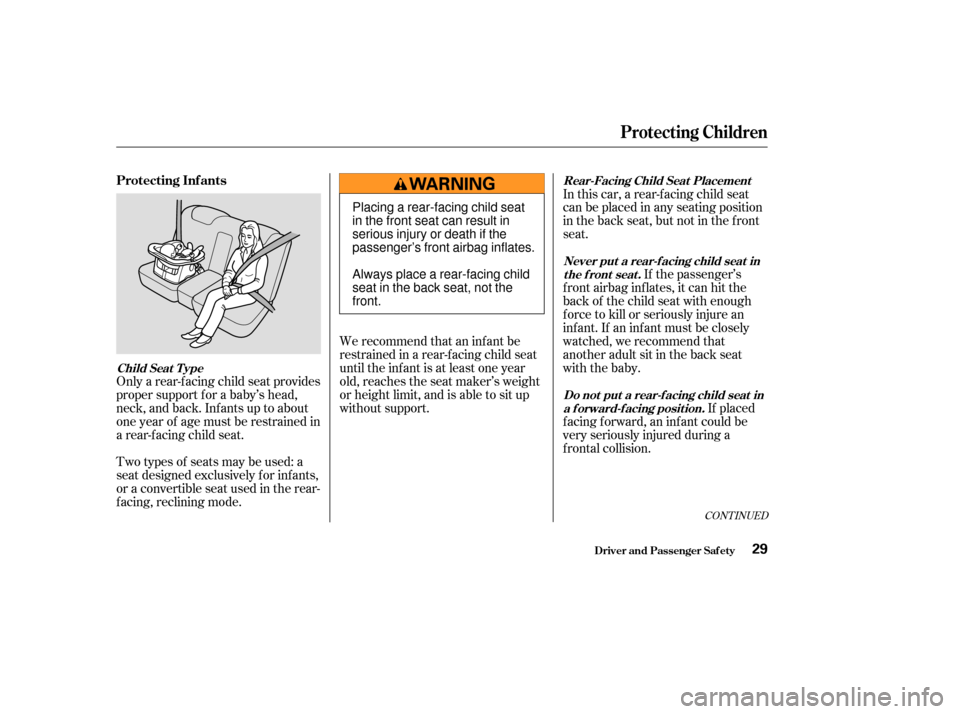
Only a rear-f acing child seat provides
proper support f or a baby’s head,
neck, and back. Inf ants up to about
one year of age must be restrained in
a rear-f acing child seat.In this car, a rear-f acing child seat
can be placed in any seating position
in the back seat, but not in the front
seat.
Two types of seats may be used: a
seat designed exclusively f or inf ants,
or a convertible seat used in the rear-
f acing, reclining mode. If the passenger’s
f ront airbag inf lates, it can hit the
back of the child seat with enough
f orce to kill or seriously injure an
inf ant. If an inf ant must be closely
watched, we recommend that
another adult sit in the back seat
with the baby.
If placed
f acing f orward, an inf ant could be
very seriously injured during a
f rontal collision.
We recommend that an inf ant be
restrained in a rear-f acing child seat
until the inf ant is at least one year
old, reaches the seat maker’s weight
or height limit, and is able to sit up
without support.
CONT INUED
Protecting Inf ants
Child Seat T ype Rear-Facing Child Seat Placement
Never put a rear-f acing child seat inthe front seat.
Do not put a rear-f acing child seat ina f orward-f acing position.
Protecting Children
Driver and Passenger Saf ety29
Placing a rear-facing child seat
in the front seat can result in
serious injury or death if the
passenger’s front airbag inflates.
Always place a rear-facing child
seat in the back seat, not the
front.
Page 33 of 355
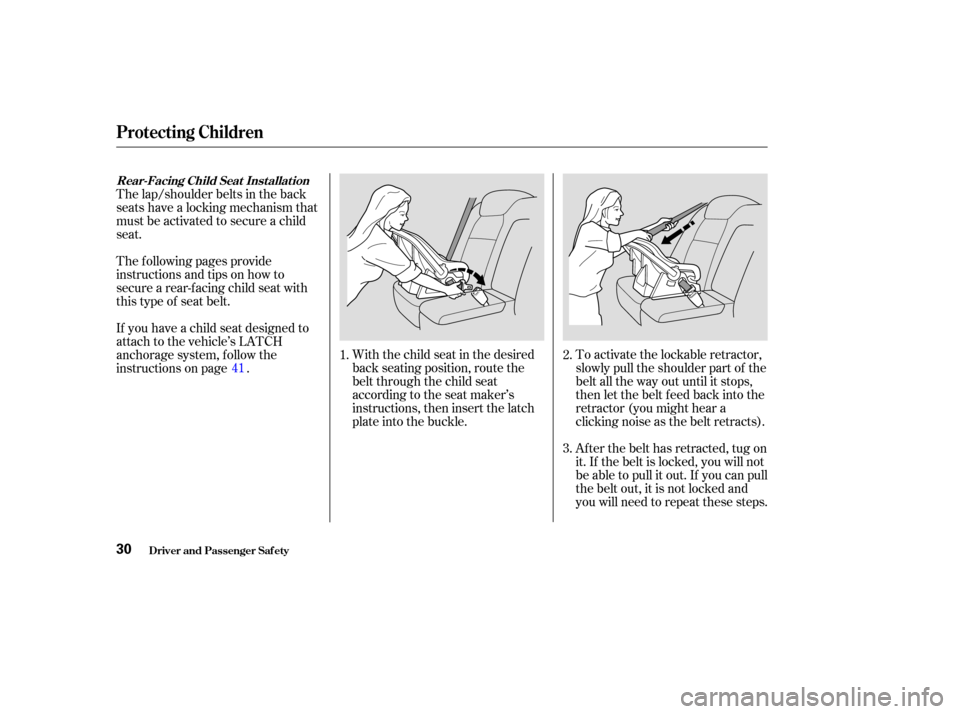
With the child seat in the desired
back seating position, route the
belt through the child seat
according to the seat maker’s
instructions, then insert the latch
plate into the buckle.To activate the lockable retractor,
slowly pull the shoulder part of the
belt all the way out until it stops,
then let the belt f eed back into the
retractor (you might hear a
clicking noise as the belt retracts).
Af ter the belt has retracted, tug on
it. If the belt is locked, you will not
be able to pull it out. If you can pull
the belt out, it is not locked and
you will need to repeat these steps.
The lap/shoulder belts in the back
seats have a locking mechanism that
must be activated to secure a child
seat.
The f ollowing pages provide
instructions and tips on how to
secure a rear-f acing child seat with
this type of seat belt.
If you have a child seat designed to
attach to the vehicle’s LATCH
anchorage system, follow the
instructions on page .
1.
2.
3.
41
Rear-Facing Child Seat Inst allat ion
Protecting Children
Driver and Passenger Saf ety30
Page 34 of 355
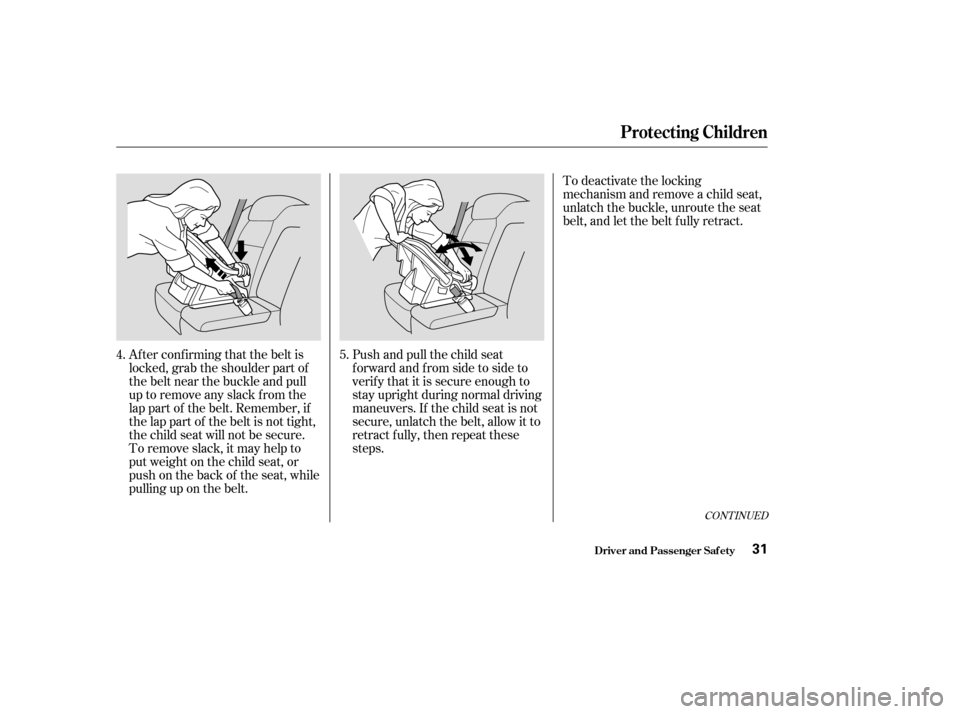
Af ter conf irming that the belt is
locked, grab the shoulder part of
the belt near the buckle and pull
up to remove any slack from the
lap part of the belt. Remember, if
the lap part of the belt is not tight,
the child seat will not be secure.
To remove slack, it may help to
putweightonthechildseat,or
push on the back of the seat, while
pulling up on the belt.Push and pull the child seat
f orward and f rom side to side to
verif y that it is secure enough to
stay upright during normal driving
maneuvers. If the child seat is not
secure, unlatch the belt, allow it to
retract f ully, then repeat these
steps.To deactivate the locking
mechanism and remove a child seat,
unlatch the buckle, unroute the seat
belt, and let the belt f ully retract.
4. 5.
CONT INUED
Protecting Children
Driver and Passenger Saf ety31
Page 35 of 355
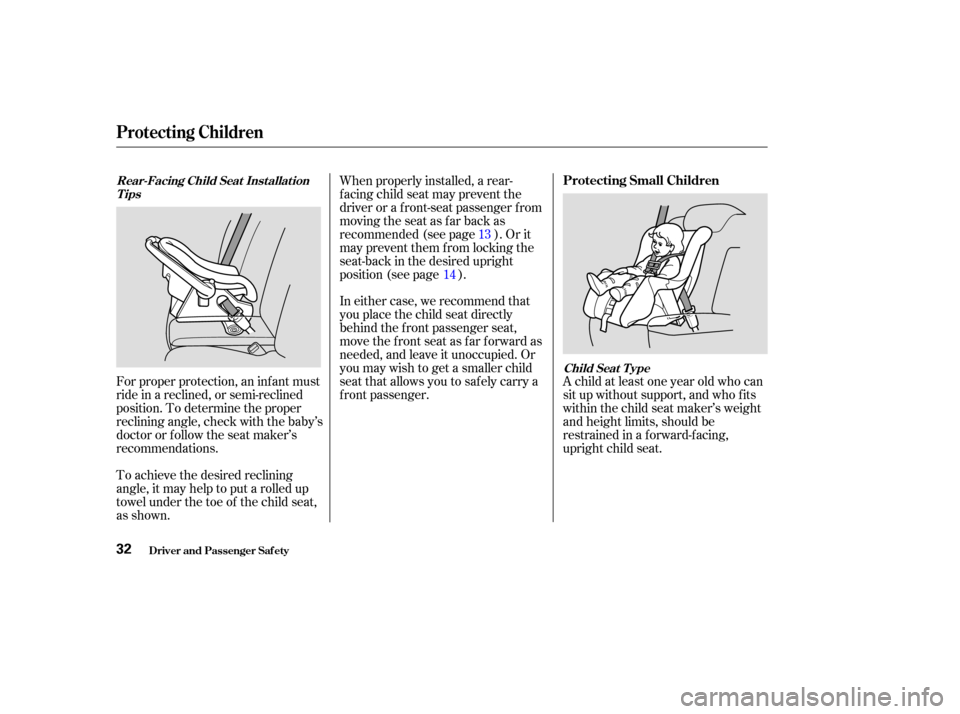
In either case, we recommend that
you place the child seat directly
behind the f ront passenger seat,
move the front seat as far forward as
needed, and leave it unoccupied. Or
you may wish to get a smaller child
seat that allows you to safely carry a
f ront passenger. When properly installed, a rear-
f acing child seat may prevent the
driver or a f ront-seat passenger f rom
moving the seat as far back as
recommended (see page ). Or it
may prevent them f rom locking the
seat-back in the desired upright
position (see page ).
To achieve the desired reclining
angle, it may help to put a rolled up
towel under the toe of the child seat,
as shown. Forproperprotection,aninfantmust
ride in a reclined, or semi-reclined
position. To determine the proper
reclining angle, check with the baby’s
doctor or f ollow the seat maker’s
recommendations. A child at least one year old who can
sit up without support, and who f its
within the child seat maker’s weight
and height limits, should be
restrained in a f orward-f acing,
upright child seat.
13
14
Rear-Facing Child Seat Inst allat ion Tips
Child Seat T ype
Protecting Children
Driver and Passenger Saf ety
Protecting Small Children
32
Page 36 of 355
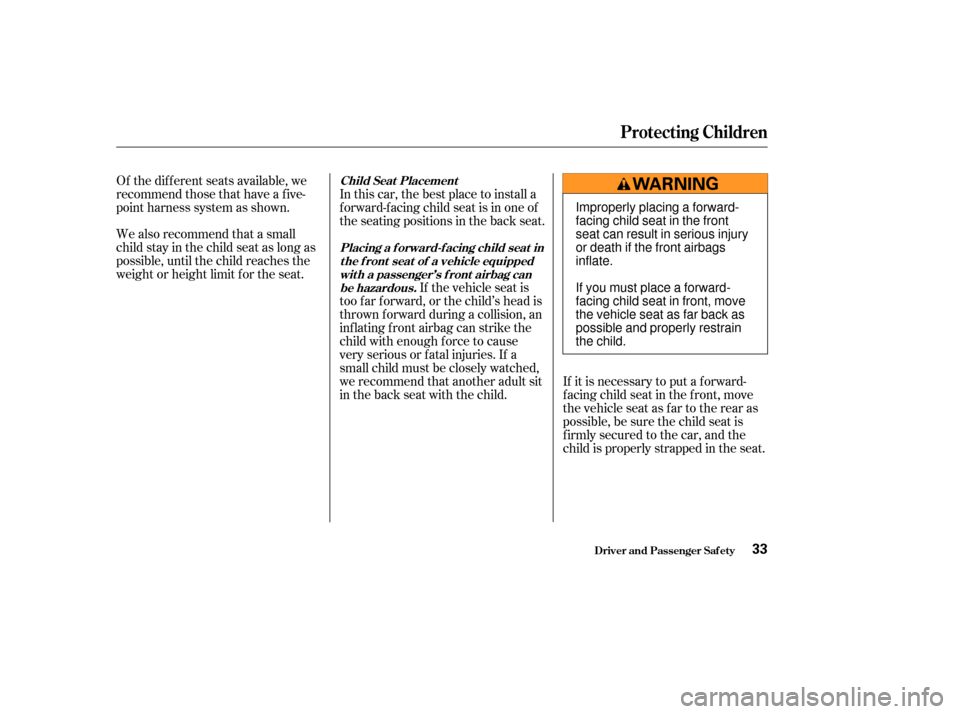
If it is necessary to put a f orward-
f acing child seat in the f ront, move
the vehicle seat as far to the rear as
possible, be sure the child seat is
f irmly secured to the car, and the
child is properly strapped in the seat.
Of the different seats available, we
recommend those that have a f ive-
point harness system as shown.
We also recommend that a small
child stay in the child seat as long as
possible, until the child reaches the
weight or height limit f or the seat.
In this car, the best place to install a
f orward-f acing child seat is in one of
the seating positions in the back seat.
If the vehicle seat is
too far forward, or the child’s head is
thrown f orward during a collision, an
inflating front airbag can strike the
child with enough f orce to cause
very serious or f atal injuries. If a
small child must be closely watched,
we recommend that another adult sit
in the back seat with the child.
Protecting Children
Driver and Passenger Saf ety
Child Seat Placement
Placing a f orward-f acing child seat int he f ront seat of a vehicle equippedwit h a passenger’s f ront airbag canbe hazardous.
33
Improperly placing a forward-
facing child seat in the front
seat can result in serious injury
or death if the front airbags
inflate.
Ifyoumustplaceaforward-
facing child seat in front, move
the vehicle seat as far back as
possible and properly restrain
the child.
Page 37 of 355
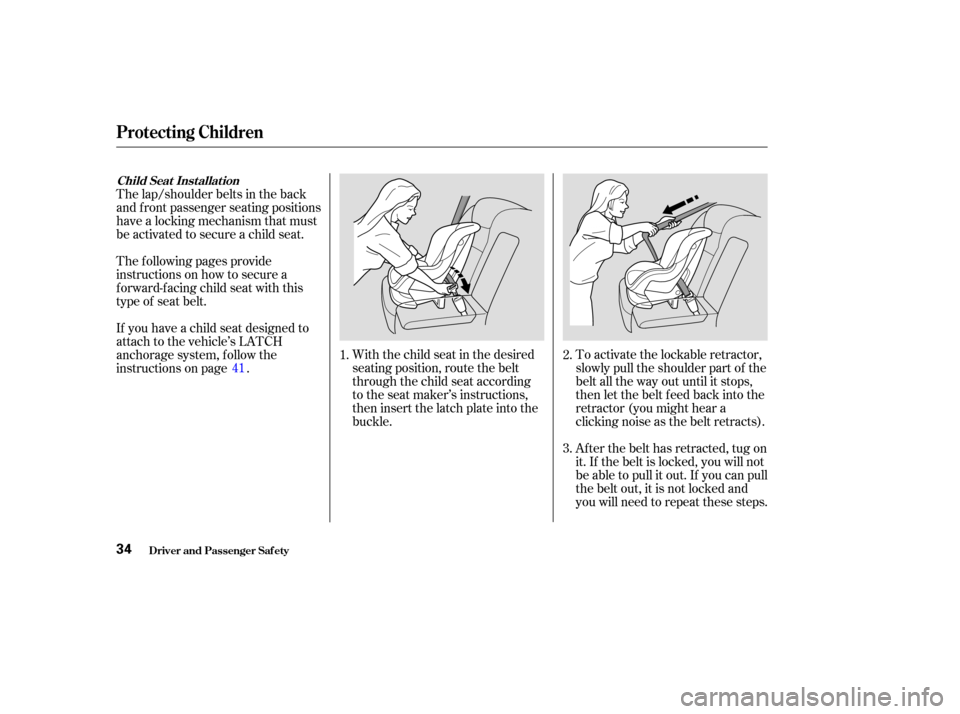
To activate the lockable retractor,
slowly pull the shoulder part of the
belt all the way out until it stops,
then let the belt f eed back into the
retractor (you might hear a
clicking noise as the belt retracts).
Af ter the belt has retracted, tug on
it. If the belt is locked, you will not
be able to pull it out. If you can pull
the belt out, it is not locked and
you will need to repeat these steps.
The lap/shoulder belts in the back
and f ront passenger seating positions
have a locking mechanism that must
be activated to secure a child seat.
The f ollowing pages provide
instructions on how to secure a
f orward-f acing child seat with this
type of seat belt.
With the child seat in the desired
seating position, route the belt
through the child seat according
to the seat maker’s instructions,
then insert the latch plate into the
buckle.
If you have a child seat designed to
attach to the vehicle’s LATCH
anchorage system, follow the
instructions on page .
1.
2.
3.
41
Child Seat Inst allat ion
Protecting Children
Driver and Passenger Saf ety34
Page 38 of 355
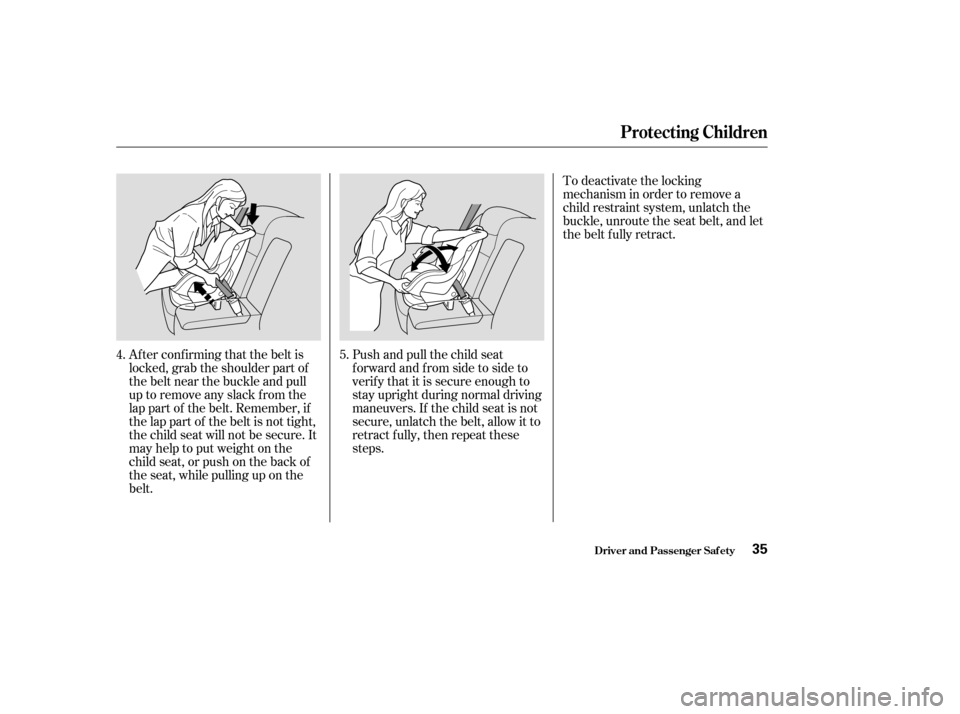
Af ter conf irming that the belt is
locked, grab the shoulder part of
the belt near the buckle and pull
up to remove any slack from the
lap part of the belt. Remember, if
the lap part of the belt is not tight,
the child seat will not be secure. It
mayhelptoputweightonthe
child seat, or push on the back of
the seat, while pulling up on the
belt.Push and pull the child seat
f orward and f rom side to side to
verif y that it is secure enough to
stay upright during normal driving
maneuvers. If the child seat is not
secure, unlatch the belt, allow it to
retract f ully, then repeat these
steps.To deactivate the locking
mechanism in order to remove a
child restraint system, unlatch the
buckle, unroute the seat belt, and let
the belt fully retract.
4. 5.
Protecting Children
Driver and Passenger Saf ety35
Page 39 of 355
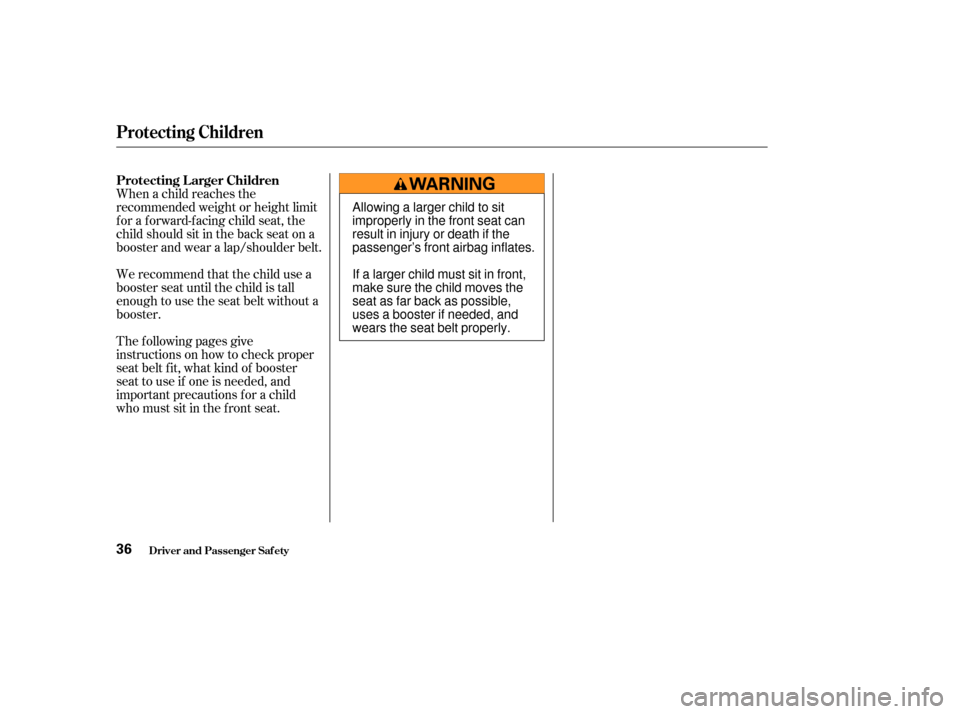
When a child reaches the
recommended weight or height limit
for a forward-facing child seat, the
child should sit in the back seat on a
booster and wear a lap/shoulder belt.
We recommend that the child use a
booster seat until the child is tall
enough to use the seat belt without a
booster.
The f ollowing pages give
instructions on how to check proper
seat belt f it, what kind of booster
seat to use if one is needed, and
important precautions f or a child
who must sit in the f ront seat.
Protecting Children
Driver and Passenger Saf ety
Protecting L arger Children
36
Allowing a larger child to sit
improperly in the front seat can
result in injury or death if the
passenger’s front airbag inflates.
If a larger child must sit in front,
make sure the child moves the
seat as far back as possible,
uses a booster if needed, and
wears the seat belt properly.
Page 40 of 355
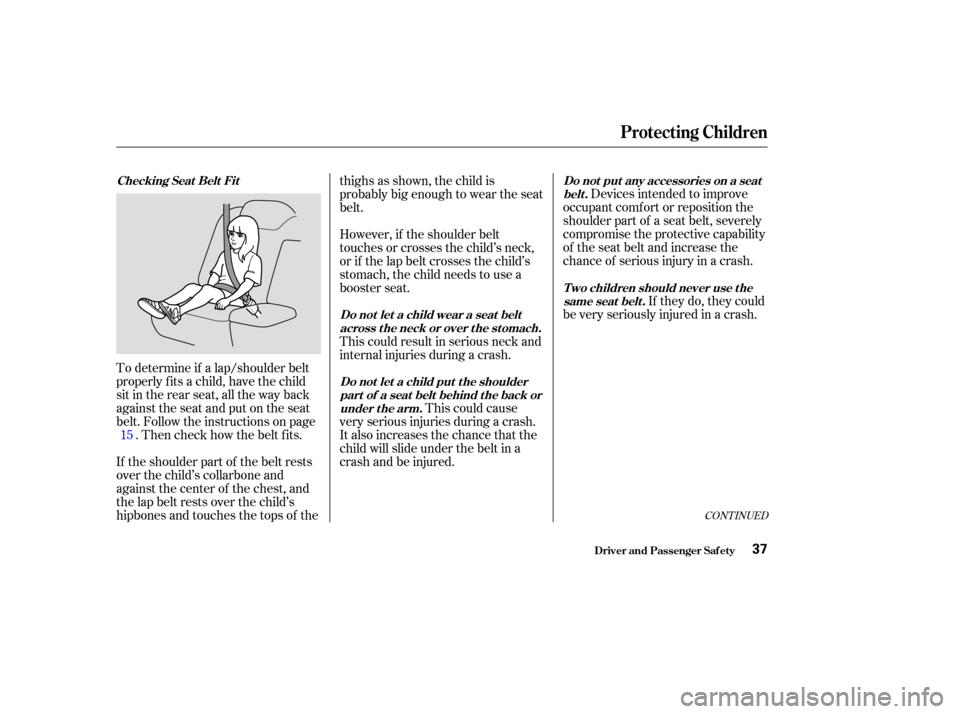
Devices intended to improve
occupant comf ort or reposition the
shoulder part of a seat belt, severely
compromise the protective capability
of the seat belt and increase the
chance of serious injury in a crash.
If they do, they could
be very seriously injured in a crash.
To determine if a lap/shoulder belt
properly f its a child, have the child
sit in the rear seat, all the way back
against the seat and put on the seat
belt. Follow the instructions on page . Then check how the belt f its.
If the shoulder part of the belt rests
over the child’s collarbone and
against the center of the chest, and
the lap belt rests over the child’s
hipbones and touches the tops of the thighs as shown, the child is
probably big enough to wear the seat
belt.
However, if the shoulder belt
touchesorcrossesthechild’sneck,
or if the lap belt crosses the child’s
stomach, the child needs to use a
booster seat.
This could result in serious neck and
internal injuries during a crash.
This could cause
very serious injuries during a crash.
It also increases the chance that the
child will slide under the belt in a
crash and be injured.
15
CONT INUED
Do not put any accessories on a seat
belt.
T wo children should never use t hesame seat belt .
Checking Seat Belt Fit
Do not let a child wear a seat beltacross t he neck or over t he st omach.
Do not let a child put the shoulderpart of a seat belt behind t he back orunder t he arm.
Protecting Children
Driver and Passenger Saf ety37